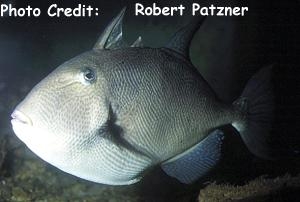
By Bob Goemans

Not Reef Tank Suitable
Likely Fish-Only Tank Suitable
Range: Eastern Atlantic Ocean: Mediterranean to Angola, and also in the western Atlantic Ocean: Nova Scotia to Bermuda, Gulf of Mexico to Argentina
Size: 24 inches (60 cm)
Natural Environment: Inhabits bays, lagoons and seaward reefs often at depths of about 10 – 180 feet (3 – 55 m) and is sometimes found in drifting Sargassum seaweed. Usually solitary, yet may be found in small groups. Seeks caves or coral branches to hide or rest during evening hours. Feeds mostly on clams, crustaceans, and worms.
General Husbandry: Rarely seen in the general trade/local shops because it's not only quite aggressive and large, its somewhat drab, even as an juvenile. Basically, its subadult colors are an overall grayish greenish with three darker vertical bands on the body and a single band on the chin. There’s also some blue spots and lines on the dorsal fin and upper parts of the body, with the second dorsal and anal fins somewhat marbled. As it ages, it becomes overly grayish in coloration.
In the home aquarium, they require a meaty diet, e.g., chopped fish, shrimp, squid, and clam flesh, and/or meaty type frozen carnivore foods with two or three feedings per day highly recommended. If maintained with other fish, they should be larger more aggressive fish, such as large moray eels, snappers, angelfish, tangs or other larger fish that can defend themselves, yet not lionfish, as they are too slow moving and a target for fin nipping. May also re-aquascape your aquarium and make a mess of the sandbed due to its constant searching for infauna/invertebrates. Will also bite the hand that feeds it, so do not place your hands in the aquarium! As to its environmental needs, provide enough rocky caves for it to hide or sleep in. Keep in mind that generally its recommended not more than one triggerfish be kept per aquarium unless a mated pair, and furthermore, that it be the last fish to be placed into the aquarium.
Taxonomy:
Order: Tetraodontiformes
Suborder: Tetraodontoidei
Family: Balistidae
Genus: Balistes
FYI: Their common name, triggerfish, comes from their ability to lock and unlock their first dorsal fin. This fin is normally retracted and carried in a groove on the upper body. When frightened, the fish will dart into a crevice or branch of coral and raise this trigger-like fin, securely locking itself into its place of protection.
They should be housed with small pieces of seashells since they like to bite on them or turn them over in the search of prey. Better these shells than other aquarium decor. It also helps keep their teeth worn-down, which actually could get too long and pointed and cause them some difficulty in feeding.
In general, triggerfish are like angelfish and surgeonfishes, as they have laterally compressed bodies with small mouths with strong jaws and chisel-like teeth for crushing hard-shelled prey. However, eyes are set back and located high on their large head to avoid damage when feeding on urchins, one of their favorite foods.
Preys on sea urchins by squirting water from the mouth under them to overturn, then attacks its meaty underside.
Even though specimen and confines specific, those in the genera Balistes, Balistoides, Pseudobalistes, Rhinecanthus, and Sufflamen are generally thought of as the most aggressive in the Triggerfish family. Those in the Melichthys, Odonus and Xanthichthys genera are more suitable community fish candidates, yet all are not trust worthy when it comes to invertebrates as mentioned above.
Care Level: Intermediate
Temperament: Aggressive
Diet: Carnivore
Acclimation Time: 15 minutes+
Aquarium Environment: Fish-only aquarium
Coral Safe: No
Invertebrate Safe: No
Tankmates: Equal in size or larger/may attack/eat smaller fish
Minimum Tank Size: 200 gallons
Temperature Range: 72 - 82°F (22 – 27°C)
Specific Gravity: 1.020-1.026
pH: 7.9 - 8.5
